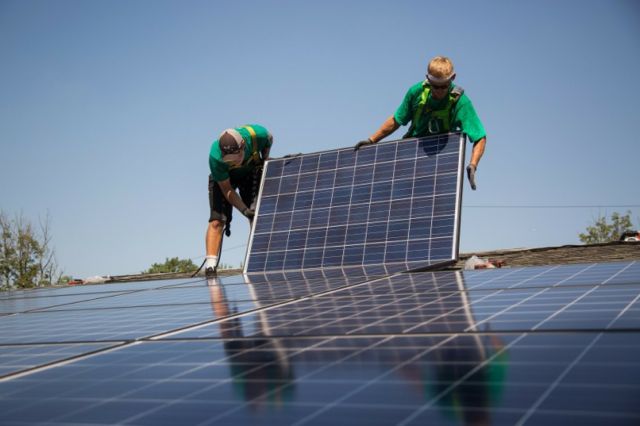forum
library
tutorial
contact

Solar Energy is Poised for
Yet Another Record Year
by Chris Mooney
Washington Post, September 9, 2015
|
the film forum library tutorial contact |

|
Solar Energy is Poised for
by Chris Mooney
|
Overall, the U.S. had over 1000 gigawatts of electricity capacity installed as of the year 2012, ...
 The U.S. solar industry is on course for a new growth record in 2015, according to a new report that finds that solar photovoltaic installations now exceed 20 gigawatts in capacity and could surpass an unprecedented 7 gigawatts this year alone across all segments. A gigawatt is equivalent to 1 billion watts and can power some 164,000 homes, according to the Solar Energy Industries Association (SEIA).
The U.S. solar industry is on course for a new growth record in 2015, according to a new report that finds that solar photovoltaic installations now exceed 20 gigawatts in capacity and could surpass an unprecedented 7 gigawatts this year alone across all segments. A gigawatt is equivalent to 1 billion watts and can power some 164,000 homes, according to the Solar Energy Industries Association (SEIA).
The new report, from GTM Research and SEIA, covers the second quarter of 2015, which set a new record for residential rooftop solar installations in particular, a category that saw 70 percent year-over-year growth. 473 megawatts of residential solar capacity were installed, or nearly half a gigawatt.
"It's setting records every quarter," says Shayle Kann, senior vice president of GTM Research and lead author of the report, of the residential segment.
The report comes just weeks after President Obama traveled to Las Vegas -- a particularly fast-paced solar market -- to sing the industry's praises and cast solar, and particularly "distributed" solar on rooftops, as an icon of progress and technological innovation.
"This is an age-old debate in America," the president said. "It's a debate between the folks who say 'no, we can't,' and the folks who say, 'yes, we can.'"
The new GTM Research and Solar Energy Industries Association report suggests the "yes, we can" crowd is winning, finding that out of all new electricity installations in the U.S. in the first six months of this year, 40 percent were solar.
Last year saw 6.2 gigawatts of solar photovoltaic installations, but the report is projecting a total of 7.7 gigawatts this year, as a large number of utility scale solar projects (the single biggest part of the market) come online, even as residential solar continues its rapid growth as well. "There's no way it's not a record year, the question is how much we break the record by," Kann says.
And even in the market segment where performance wasn't as strong last quarter -- the non-residential market, neither rooftop based nor utility scale -- things are expected to pick-up. So called "community" or "shared" solar -- in which residents of a neighborhood, condo or apartment building invest collectively in a larger solar installation -- falls into this category, and is expected to see rapid growth. "Shared solar or community solar is a market that's just emerging, and we think has real legs," Kann says.
What it all means, according to Kann, is that U.S. solar photovoltaic is at 20 gigawatts of installed capacity now, and may add another 18 gigawatts by the end of next year. Overall, the growth boom is being fueled by a combination of declining costs, low interest rates, and a federal solar investment tax credit, the report suggests.
For comparison, according to the Department of Energy, the wind industry in the U.S. recently reached 66 gigawatts of installed capacity, with 13 more gigawatts expected to come online by the end of 2016. Overall, the U.S. had over 1000 gigawatts of electricity capacity installed as of the year 2012, according to the U.S. Energy Information Administration. So while still a minority of all electricity generation, wind and solar are, nonetheless, growing more and more significant on a national scale.
Still, there are storms ahead. The GTM Research and SEIA report points out that after 2016, if the solar investment tax credit is allowed to decline, the industry will face considerable uncertainty from 2017 to 2019 that could hampered growth. The situation is expected to then change again after 2020, as a key incentive program that's part of the federal Clean Power Plan goes into effect, which will strongly favor solar and wind.
The new report also looks towards a tiny market at present that nonetheless contains great potential -- solar-plus-storage, in which solar installations are combined directly with batteries in order to preserve energy culled from the sun for use at times of convenience or greater demand.
Even though this market remains minuscule for the moment, "industry activity and discussion around this technology combination has been frantic," notes the report. It finds that while only 4 megawatts of solar-plus-storage were deployed last year, by this year that could increase five fold -- and by 2020 it could reach 769 megawatts.
learn more on topics covered in the film
see the video
read the script
learn the songs
discussion forum
